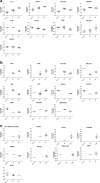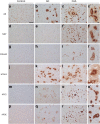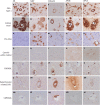Proteomics analysis identifies new markers associated with capillary cerebral amyloid angiopathy in Alzheimer's disease
- PMID: 29860944
- PMCID: PMC5985582
- DOI: 10.1186/s40478-018-0540-2
Proteomics analysis identifies new markers associated with capillary cerebral amyloid angiopathy in Alzheimer's disease
Abstract
Alzheimer's disease (AD) is characterized by amyloid beta (Aβ) deposits as plaques in the parenchyma and in the walls of cortical and leptomeningeal blood vessels of the brain called cerebral amyloid angiopathy (CAA). It is suggested that CAA type-1, which refers to amyloid deposition in both capillaries and larger vessels, adds to the symptomatic manifestation of AD and correlates with disease severity. Currently, CAA cannot be diagnosed pre-mortem and disease mechanisms involved in CAA are elusive. To obtain insight in the disease mechanism of CAA and to identify marker proteins specifically associated with CAA we performed a laser dissection microscopy assisted mass spectrometry analysis of post-mortem human brain tissue of (I) AD cases with only amyloid deposits in the brain parenchyma and no vascular related amyloid, (II) AD cases with severe CAA type-1 and no or low numbers of parenchymal amyloid deposits and (III) cognitively healthy controls without amyloid deposits. By contrasting the quantitative proteomics data between the three groups, 29 potential CAA-selective proteins were identified. A selection of these proteins was analysed by immunoblotting and immunohistochemistry to confirm regulation and to determine protein localization and their relation to brain pathology. In addition, specificity of these markers in relation to other small vessel diseases including prion CAA, CADASIL, CARASAL and hypertension related small vessel disease was assessed using immunohistochemistry.Increased levels of clusterin (CLU), apolipoprotein E (APOE) and serum amyloid P-component (APCS) were observed in AD cases with CAA. In addition, we identified norrin (NDP) and collagen alpha-2(VI) (COL6A2) as highly selective markers that are clearly present in CAA yet virtually absent in relation to parenchymal amyloid plaque pathology. NDP showed the highest specificity to CAA when compared to other small vessel diseases. The specific changes in the proteome of CAA provide new insight in the pathogenesis and yields valuable selective biomarkers for the diagnosis of CAA.
Keywords: Alzheimer’s disease; Amyloid beta; Biomarker; Cerebral amyloid angiopathy; Human brain; Laser microdissection; Post-mortem tissue; Proteomics.
Conflict of interest statement
Competing interests
A selection of proteins including, but not limited to, NDP, CLU, APOE, HTRA1, APCS, COL6A2 and COL6A3 are part of the patent application P113281EP00.
Publisher’s Note
Springer Nature remains neutral with regard to jurisdictional claims in published maps and institutional affiliations.
Figures







Similar articles
-
APOE epsilon 4 influences the pathological phenotype of Alzheimer's disease by favouring cerebrovascular over parenchymal accumulation of A beta protein.Neuropathol Appl Neurobiol. 2003 Jun;29(3):231-8. doi: 10.1046/j.1365-2990.2003.00457.x. Neuropathol Appl Neurobiol. 2003. PMID: 12787320
-
Tissue transglutaminase-catalysed cross-linking induces Apolipoprotein E multimers inhibiting Apolipoprotein E's protective effects towards amyloid-beta-induced toxicity.J Neurochem. 2015 Sep;134(6):1116-28. doi: 10.1111/jnc.13203. Epub 2015 Jul 7. J Neurochem. 2015. PMID: 26088696
-
Capillary cerebral amyloid angiopathy identifies a distinct APOE epsilon4-associated subtype of sporadic Alzheimer's disease.Acta Neuropathol. 2010 Aug;120(2):169-83. doi: 10.1007/s00401-010-0707-9. Epub 2010 Jun 10. Acta Neuropathol. 2010. PMID: 20535486
-
Cerebral amyloid angiopathy and its relationship to Alzheimer's disease.Acta Neuropathol. 2008 Jun;115(6):599-609. doi: 10.1007/s00401-008-0366-2. Epub 2008 Mar 28. Acta Neuropathol. 2008. PMID: 18369648 Review.
-
Cerebral amyloid angiopathy and dementia.Panminerva Med. 2004 Dec;46(4):253-64. Panminerva Med. 2004. PMID: 15876981 Review.
Cited by
-
Sorcin is an early marker of neurodegeneration, Ca2+ dysregulation and endoplasmic reticulum stress associated to neurodegenerative diseases.Cell Death Dis. 2020 Oct 15;11(10):861. doi: 10.1038/s41419-020-03063-y. Cell Death Dis. 2020. PMID: 33060591 Free PMC article.
-
Neuroproteomics of the Synapse: Subcellular Quantification of Protein Networks and Signaling Dynamics.Mol Cell Proteomics. 2021;20:100087. doi: 10.1016/j.mcpro.2021.100087. Epub 2021 Apr 29. Mol Cell Proteomics. 2021. PMID: 33933679 Free PMC article. Review.
-
Mass spectrometry-based methods for robust measurement of Alzheimer's disease biomarkers in biological fluids.J Neurochem. 2021 Oct;159(2):211-233. doi: 10.1111/jnc.15465. Epub 2021 Aug 25. J Neurochem. 2021. PMID: 34244999 Free PMC article. Review.
-
Comparison of Plasma Lipoprotein Composition and Function in Cerebral Amyloid Angiopathy and Alzheimer's Disease.Biomedicines. 2021 Jan 12;9(1):72. doi: 10.3390/biomedicines9010072. Biomedicines. 2021. PMID: 33445800 Free PMC article.
-
Sorcin: mechanisms of action in cancer hallmarks, drug resistance and opportunities in therapeutics.Med Oncol. 2024 Dec 14;42(1):29. doi: 10.1007/s12032-024-02580-6. Med Oncol. 2024. PMID: 39673665 Review.
References
-
- Richard E, Carrano A, Hoozemans JJ, Van Horssen J, Van Haastert ES, Eurelings LS, De Vries HE, Thal DR, Eikelenboom P, Van Gool WA, Rozemuller AJM. Characteristics of dyshoric capillary cerebral amyloid angiopathy. J Neuropathol Exp Neurol. 2010;69:1158–1167. doi: 10.1097/NEN.0b013e3181fab558. - DOI - PubMed
Publication types
MeSH terms
Substances
LinkOut - more resources
Full Text Sources
Other Literature Sources
Medical
Research Materials
Miscellaneous

